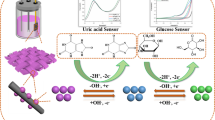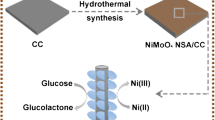Abstract
A new electrocatalytic biosensor (MOF-74(Cu) NS-CC) based on the in situ deposition of MOF-74(Cu) nanosheet on carbon cloth via a bottom-up synthetic approach in a glass tube was developed. The electrocatalytic activity of the deposited MOF-74(Cu) NS was demonstrated in the oxidation of glucose to gluconate under alkaline conditions. The results revealed that the proposed method of in situ formation of MOF-74(Cu) NS onto a carbon cloth surface in a multi-layer solution is capable to generate a stable MOF-74(Cu) NS-CC electrode with excellent sensing performance. When the as-synthesized MOF-74(Cu) NS-CC was applied directly as the working electrode for glucose sensing, it showed much higher conductivity and redox activity than MOF-74(Cu) NS-GCE. With the potential applied at 0.55 V (vs. Ag/AgCl), this new electrocatalytic biosensor exhibits an excellent linear relationship between current density and concentration of glucose. Moreover, a wide linear range of detection (1.0 to 1000 μM) was observed. The limit of detection was found to be 0.41 μM (S/N = 3). The response sensitivity is 3.35 mA mM−1 cm−2 when the concentration of glucose is in the range 1–100 μM and 3.81 mA mM−1 cm−2 for the 100–1000 μM concentration range. This study provides a low-cost, easy to prepare, and reproducible methodology for the synthesis of highly redox-active nanomaterials based on the in situ formation of two-dimensional MOF-74(Cu) NS for the development of new electrocatalytic biosensors.

Graphical abstract





Similar content being viewed by others
References
Pang Y, Zang X, Li H, Liu J, Chang Q, Zhang S, Wang C, Wang Z (2020) Solid-phase microextraction of organophosphorous pesticides from food samples with a nitrogen-doped porous carbon derived from g-C3N4 templated MOF as the fiber coating. J Hazard Mater 384:121430
Li JT, Huang WZ, Wang MM, Xi SB, Meng JS, Zhao KN, Jin J, Xu WW, Wang ZY, Liu X, Chen Q, Xu LH, Liao XB, Jiang YL, Owusu KA, Jiang BL, Chen CX, Fan DNA, Zhou L, Mai LQ (2019) Low-crystalline bimetallic metal-organic framework electrocatalysts with rich active sites for oxygen evolution. Acs Energy Letters 4:285–292
Fan WD, Wang X, Liu XP, Xu B, Zhang XR, Wang WJ, Wang XK, Wang YT, Dai FN, Yuan DQ, Sun DF (2019) Regulating C2H2 and CO2 storage and separation through pore environment modification in a microporous Ni-MOF. ACS Sustain Chem Eng 7:2134–2140
Cabrera-Garcia A, Checa-Chavarria E, Rivero-Buceta E, Moreno V, Fernandez E, Botella P (2019) Amino modified metal-organic frameworks as pH-responsive nanoplatforms for safe delivery of camptothecin. J Colloid Interface Sci 541:163–174
Lai H, Li G, Xu F, Zhang Z (2020) Metal–organic frameworks: opportunities and challenges for surface-enhanced Raman scattering–a review. J Mater Chem C 8:2952–2963
Hu S, Ouyang W, Guo L, Lin Z, Jiang X, Qiu B, Chen G (2017) Facile synthesis of Fe3O4/g-C3N4/HKUST-1 composites as a novel biosensor platform for ochratoxin A. Biosens Bioelectron 92:718–723
Song JY, He WT, Shen H, Zhou ZX, Li MQ, Su P, Yang Y (2019) Construction of multiple enzyme metal-organic frameworks biocatalyst via DNA scaffold: a promising strategy for enzyme encapsulation. Chem Eng J 363:174–182
Gkaniatsou E, Sicard C, Ricoux R, Benahmed L, Bourdreux F, Zhang Q, Serre C, Mahy JP, Steunou N (2018) Enzyme encapsulation in mesoporous metal-organic frameworks for selective biodegradation of harmful dye molecules. Angewandte Chemie-International Edition 57:16141–16146
Yi XR, He XB, Yin FX, Chen BH, Li GR, Yin HQ (2019) Co-CoO-Co3O4/N-doped carbon derived from metal-organic framework: the addition of carbon black for boosting oxygen electrocatalysis and Zn-air battery. Electrochim Acta 295:966–977
Mukherjee S, Cullen DA, Karakalos S, Liu KX, Zhang H, Zhao S, Xu H, More KL, Wang GF, Wu G (2018) Metal-organic framework- derived nitrogen-doped highly disordered carbon for electrochemical ammonia synthesis using N-2 and H2O in alkaline electrolytes. Nano Energy 48:217–226
Hu SS, Yan JJ, Huang XM, Guo LH, Lin ZY, Luo F, Qiu B, Wong KY, Chen GN (2018) A sensing platform for hypoxanthine detection based on amino-functionalized metal organic framework nanosheet with peroxidase mimic and fluorescence properties. Sensors and Actuators B-Chemical 267:312–319
Salunkhe RR, Kaneti YV, Kim J, Kim JH, Yamauchi Y (2016) Nanoarchitectures for metal-organic framework-derived nanoporous carbons toward supercapacitor applications. Acc Chem Res 49:2796–2806
Zhong H, Ly KH, Wang M, Krupskaya Y, Han X, Zhang J, Zhang J, Kataev V, Büchner B, Weidinger IM (2019) A phthalocyanine-based layered two-dimensional conjugated metal–organic framework as a highly efficient electrocatalyst for the oxygen reduction reaction. Angew Chem 131:10787–10792
Xiao Q-Q, Liu D, Wei Y-L, Cui G-H (2019) A new multifunctional two-dimensional cobalt (II) metal–organic framework for electrochemical detection of hydrogen peroxide, luminescent sensing of metal ions, and photocatalysis. Polyhedron 158:342–351
Zhao M, Wang Y, Ma Q, Huang Y, Zhang X, Ping J, Zhang Z, Lu Q, Yu Y, Xu H (2015) Ultrathin 2D metal–organic framework nanosheets. Adv Mater 27:7372–7378
Wang Q, Yang Y, Gao F, Ni J, Zhang Y, Lin Z (2016) Graphene oxide directed one-step synthesis of flowerlike graphene@ HKUST-1 for enzyme-free detection of hydrogen peroxide in biological samples. ACS Appl Mater Interfaces 8:32477–32487
Yin D, Liu J, Bo X, Li M, Guo L (2017) Porphyrinic metal-organic framework/macroporous carbon composites for electrocatalytic applications. Electrochim Acta 247:41–49
Chaudhari NK, Jin H, Kim B, Lee K (2017) Nanostructured materials on 3D nickel foam as electrocatalysts for water splitting. Nanoscale 9:12231–12247
Zha Q, Li M, Liu Z, Ni Y (2020) Hierarchical Co, Fe-MOF-74/Co/carbon cloth hybrid electrode: simple construction and enhanced catalytic performance in full water splitting. ACS Sustain Chem Eng 8:12025–12035
Zhang L, Zhang Y, Huang S, Yuan Y, Li H, Jin Z, Wu J, Liao Q, Hu L, Lu J (2018) Co3O4/Ni-based MOFs on carbon cloth for flexible alkaline battery-supercapacitor hybrid devices and near-infrared photocatalytic hydrogen evolution. Electrochim Acta 281:189–197
Hu S, Zhu L, Lam CW, Guo L, Lin Z, Qiu B, Wong KY, Chen G, Liu Z (2019) Fluorometric determination of the activity of inorganic pyrophosphatase and its inhibitors by exploiting the peroxidase mimicking properties of a two-dimensional metal organic framework. Microchim Acta 186:190
Chang J, Li H, Hou T, Duan W, Li F (2018) Paper-based fluorescent sensor via aggregation induced emission fluorogen for facile and sensitive visual detection of hydrogen peroxide and glucose. Biosens Bioelectron 104:152–157
Gu C, Gai P, Hou T, Li H, Xue C, Li F (2017) Enzymatic fuel cell-based self-powered homogeneous immunosensing platform via target-induced glucose release: an appealing alternative strategy for turn-on melamine assay. ACS Appl Mater Interfaces 9:35721–35728
Neto SA, Almeida TS, Palma LM, Minteer SD, Andrade ARD (2014) Hybrid nanocatalysts containing enzymes and metallic nanoparticles for ethanol/O 2 biofuel cell. J Power Sources 259:25–32
Mahmoud MA, O’Neil D, El-Sayed MA Hollowand solid metallic nanoparticles in sensingand in nanocatalysis. Chemistry of Materials 26:44–58
Zhao L, Thomas JP, Heinig NF, Abd-Ellah M, Wang X, Leung KT (2014) Au–Pt alloy nanocatalysts for electro-oxidation of methanol and their application for fast-response non-enzymatic alcohol sensing. J Mater Chem C 2:2707–2714
Wu XF, Bao CC, Niu QQ, Lu WB (2019) A novel method to construct a 3D FeWO4 microsphere-array electrode as a non-enzymatic glucose sensor. Nanotechnology 30:165501
Lu WB, Wu XF (2018) Ni-MOF nanosheet arrays: efficient non-noble-metal electrocatalysts for non-enzymatic monosaccharide sensing. New J Chem 42:3180–3183
Shahhoseini L, Mohammadi R, Ghanbari B, Shahrokhian S (2019) Ni(II) 1D-coordination polymer/C-60-modified glassy carbon electrode as a highly sensitive non-enzymatic glucose electrochemical sensor. Appl Surf Sci 478:361–372
Darabdhara G, Bordoloi J, Manna P, Das MR (2019) Biocompatible bimetallic Au-Ni doped graphitic carbon nitride sheets: a novel peroxidase-mimicking artificial enzyme for rapid and highly sensitive colorimetric detection of glucose. Sensors and Actuators B-Chemical 285:277–290
Dong SY, Zhang DD, Cui H, Huang TL (2019) ZnO/porous carbon composite from a mixed-ligand MOF for ultrasensitive electrochemical immunosensing of C-reactive protein. Sensors and Actuators B-Chemical 284:354–361
Li Y, Dai H, Zhang Q, Zhang S, Chen S, Hong Z, Lin Y (2016) In situ generation of electron acceptor to amplify the photoelectrochemical signal from poly (dopamine)-sensitized TiO 2 signal crystal for immunoassay. J Mater Chem B 4:2591–2597
Zhang Y, Su L, Manuzzi D, de los Monteros HVE, Jia W, Huo D, Hou C, Lei Y (2012) Ultrasensitive and selective non-enzymatic glucose detection using copper nanowires. Biosens Bioelectron 31:426–432
Kang X, Mai Z, Zou X, Cai P, Mo J (2007) A sensitive nonenzymatic glucose sensor in alkaline media with a copper nanocluster/multiwall carbon nanotube-modified glassy carbon electrode. Anal Biochem 363:143–150
Nenkova R, Wu J, Zhang Y, Godjevargova T (2013) Influence of different nanozeolite particles on the sensitivity of a glucose biosensor. Anal Biochem 439:65–72
Chen T, Liu D, Lu W, Wang K, Du G, Asiri AM, Sun X (2016) Three-dimensional Ni2P nanoarray: an efficient catalyst electrode for sensitive and selective nonenzymatic glucose sensing with high specificity. Anal Chem 88:7885–7889
Hosseini H, Rezaei SJT, Rahmani P, Sharifi R, Nabid MR, Bagheri A (2014) Nonenzymatic glucose and hydrogen peroxide sensors based on catalytic properties of palladium nanoparticles/poly(3,4-ethylenedioxythiophene) nanofibers. Sensors & Actuators B Chemical 195:85–91
Wang J, Wang Z, Zhao D, Xu C (2014) Facile fabrication of nanoporous PdFe alloy for nonenzymatic electrochemical sensing of hydrogen peroxide and glucose. Anal Chim Acta 832:34–43
Liu M, Ru L, Wei C (2013) Graphene wrapped Cu 2 O nanocubes: non-enzymatic electrochemical sensors for the detection of glucose and hydrogen peroxide with enhanced stability. Biosens Bioelectron 45:206–212
Zhao D, Xu C (2015) A nanoporous palladium-nickel alloy with high sensing performance towards hydrogen peroxide and glucose. Journal of Colloid & Interface Science 447:50–57
Li Y, Zhong Y, Zhang Y, Weng W, Li S (2015) Carbon quantum dots/octahedral Cu2O nanocomposites for non-enzymatic glucose and hydrogen peroxide amperometric sensor. Sensors Actuators B Chem 206:735–743
Gao W, Tjiu WW, Wei J, Liu T (2014) Highly sensitive nonenzymatic glucose and H2O2 sensor based on Ni (OH) 2/electroreduced graphene oxide− multiwalled carbon nanotube film modified glass carbon electrode. Talanta 120:484–490
Luo Y, Wang Q, Li J, Xu F, Sun L, Bu Y, Zou Y, Kraatz H-B, Rosei F (2020) Tunable hierarchical surfaces of CuO derived from metal–organic frameworks for non-enzymatic glucose sensing. Inorganic Chemistry Frontiers 7:1512–1525
Gu C, Wang Q, Zhang L, Yang P, Xie Y, Fei J (2020) Ultrasensitive non-enzymatic pesticide electrochemical sensor based on HKUST-1-derived copper oxide@ mesoporous carbon composite. Sensors Actuators B Chem 305:127478
Alshahrani LA, Miao L, Zhang Y, Cheng S, Sathishkumar P, Saravanakumar B, Nan J, Gu FL (2019) 3D-flower-like copper sulfide nanoflake-decorated carbon nanofragments-modified glassy carbon electrodes for simultaneous electrocatalytic sensing of co-existing hydroquinone and catechol. Sensors 19:2289
Wang J (2008) Electrochemical glucose biosensors. Chem Rev 108:814–825
Funding
This study is funded by the STS Key Project of Fujian Province (2017T3007), Nature Sciences Funding of Fujian Province (2018J01682) and the Project of Quangang District Science and Technology Bureau (2019G01), and Natural Science Foundation of Guangdong Province (2019A1515011799).
Author information
Authors and Affiliations
Corresponding authors
Ethics declarations
Conflict of interest
The authors declare that they have no competing of interests.
Additional information
Publisher’s note
Springer Nature remains neutral with regard to jurisdictional claims in published maps and institutional affiliations.
Supplementary information
ESM 1
(DOCX 11929 kb)
Rights and permissions
About this article
Cite this article
Hu, S., Lin, Y., Teng, J. et al. In situ deposition of MOF-74(Cu) nanosheet arrays onto carbon cloth to fabricate a sensitive and selective electrocatalytic biosensor and its application for the determination of glucose in human serum. Microchim Acta 187, 670 (2020). https://doi.org/10.1007/s00604-020-04634-8
Received:
Accepted:
Published:
DOI: https://doi.org/10.1007/s00604-020-04634-8




